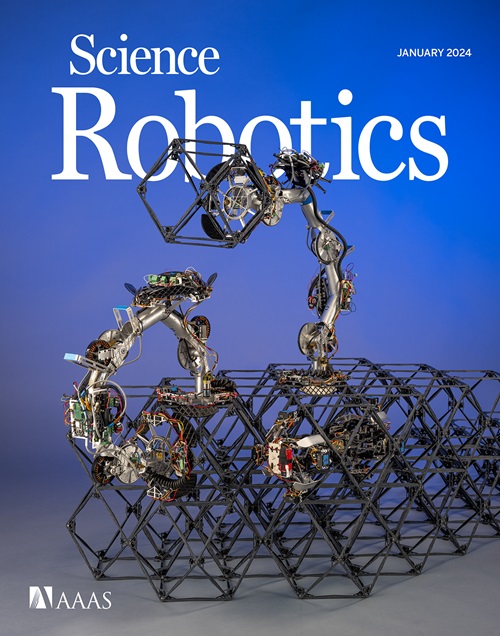High energy density picoliter-scale zinc-air microbatteries for colloidal robotics
IF 26.1
1区 计算机科学
Q1 ROBOTICS
引用次数: 0
Abstract
The recent interest in microscopic autonomous systems, including microrobots, colloidal state machines, and smart dust, has created a need for microscale energy storage and harvesting. However, macroscopic materials for energy storage have noted incompatibilities with microfabrication techniques, creating substantial challenges to realizing microscale energy systems. Here, we photolithographically patterned a microscale zinc/platinum/SU-8 system to generate the highest energy density microbattery at the picoliter (10−12 liter) scale. The device scavenges ambient or solution-dissolved oxygen for a zinc oxidation reaction, achieving an energy density ranging from 760 to 1070 watt-hours per liter at scales below 100 micrometers lateral and 2 micrometers thickness in size. The parallel nature of photolithography processes allows 10,000 devices per wafer to be released into solution as colloids with energy stored on board. Within a volume of only 2 picoliters each, these primary microbatteries can deliver open circuit voltages of 1.05 ± 0.12 volts, with total energies ranging from 5.5 ± 0.3 to 7.7 ± 1.0 microjoules and a maximum power near 2.7 nanowatts. We demonstrated that such systems can reliably power a micrometer-sized memristor circuit, providing access to nonvolatile memory. We also cycled power to drive the reversible bending of microscale bimorph actuators at 0.05 hertz for mechanical functions of colloidal robots. Additional capabilities, such as powering two distinct nanosensor types and a clock circuit, were also demonstrated. The high energy density, low volume, and simple configuration promise the mass fabrication and adoption of such picoliter zinc-air batteries for micrometer-scale, colloidal robotics with autonomous functions.
用于胶体机器人技术的高能量密度皮升级锌空气微型电池。
最近,人们对微型自主系统(包括微型机器人、胶体状态机和智能尘埃)产生了浓厚的兴趣,从而产生了对微尺度能量存储和收集的需求。然而,用于储能的宏观材料与微加工技术不兼容,给实现微尺度能源系统带来了巨大挑战。在这里,我们对锌/铂/SU-8 系统进行了光刻图案化,以产生皮升(10-12 升)级能量密度最高的微型电池。该装置可清除环境中或溶液中溶解的氧气,以进行锌氧化反应,在横向尺寸小于 100 微米、厚度小于 2 微米的情况下,能量密度可达每升 760 到 1070 瓦时。光刻工艺的并行性使每个晶片上的 10,000 个器件可以以胶体形式释放到溶液中,并储存能量。在每个仅 2 皮升的体积内,这些初级微型电池可提供 1.05 ± 0.12 伏特的开路电压,总能量从 5.5 ± 0.3 到 7.7 ± 1.0 微焦耳不等,最大功率接近 2.7 纳瓦。我们证明,这种系统可以可靠地为微米大小的忆阻器电路供电,提供非易失性存储器的访问。我们还以 0.05 赫兹的频率循环供电,以驱动微米级双态致动器的可逆弯曲,从而实现胶体机器人的机械功能。此外,我们还展示了其他功能,例如为两种不同类型的纳米传感器和时钟电路供电。这种能量密度高、体积小、配置简单的皮升级锌空气电池有望大规模制造和应用于具有自主功能的微米级胶体机器人。
本文章由计算机程序翻译,如有差异,请以英文原文为准。
求助全文
约1分钟内获得全文
求助全文
来源期刊

Science Robotics
Mathematics-Control and Optimization
CiteScore
30.60
自引率
2.80%
发文量
83
期刊介绍:
Science Robotics publishes original, peer-reviewed, science- or engineering-based research articles that advance the field of robotics. The journal also features editor-commissioned Reviews. An international team of academic editors holds Science Robotics articles to the same high-quality standard that is the hallmark of the Science family of journals.
Sub-topics include: actuators, advanced materials, artificial Intelligence, autonomous vehicles, bio-inspired design, exoskeletons, fabrication, field robotics, human-robot interaction, humanoids, industrial robotics, kinematics, machine learning, material science, medical technology, motion planning and control, micro- and nano-robotics, multi-robot control, sensors, service robotics, social and ethical issues, soft robotics, and space, planetary and undersea exploration.
 求助内容:
求助内容: 应助结果提醒方式:
应助结果提醒方式:


